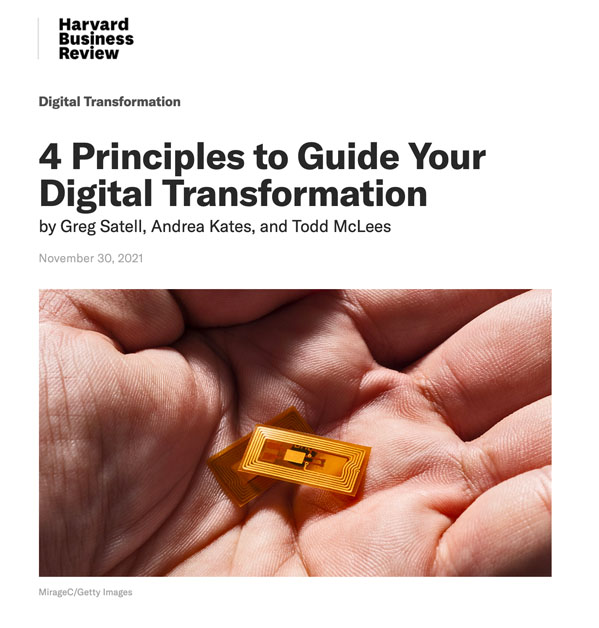Read the article at Harvard Business Review or here:
Digital transformation is not just about technology. Success involves far more than simply procuring competent vendors and doing some user training. These initiatives can no longer be left solely at the feet of technology leaders and IT staff, but must involve a diverse set of ecosystem stakeholders. we’re Clearly, digital transformation is no longer an option, but an imperative. In fact, recent research from Accenture has found that in the three years prior to 2018, firms who led their industry in enterprise technology adoption grew two times faster than laggards. Today, they are growing five times faster. The risk is no longer merely getting left behind, but being eliminated altogether.
Make no mistake, however, digital transformation is not just about technology. Success involves far more than simply procuring competent vendors and doing some user training. These initiatives can no longer be left solely at the feet of technology leaders and IT staff, but must involve a diverse set of ecosystem stakeholders.
We’re desperately in need of a shift in focus. We need to do more than just implement technology. Basic objectives such as cost optimization and process improvement can no longer be the ultimate aim. Leaders must inspire and empower their entire organization to boldly reimagine their work environment, customer needs, product offering, and even the purpose of the enterprise.
In our work helping some of the world’s top-performing organizations navigate the challenges of digital transformation, we focus on four key principles:
1. Digital Transformation Is Not The Same As Innovation
The pace of digital innovation over the past few decades has been nothing less than earth-shaking. E-commerce, social media, the mobile web, and even video streaming didn’t really begin to impact businesses until about a decade ago. Now they are significant components of the competitive environment for almost any enterprise.
So it shouldn’t be surprising that with the advanced technologies available today, such as robotic process automation, machine learning, cloud computing, and so much more, it’s easy for leaders to get lost in all of the incredible possibilities. Yet digital transformation isn’t about innovation. It’s about achieving better business outcomes.
That’s why we advise our clients to start by asking business related questions, such as “How could we better serve our customers through faster, more flexible technology?” or “How might we leverage artificial intelligence to improve employee experiences and retain top talent?” Once you identify business goals, you can work your way back to the technology decisions.
For example, one of Andrea’s clients in the online apparel industry sought to improve cost efficiency by reducing inventories. That simple objective led them to invest in systems which formed the basis for a much larger transformation that leveraged data analysis to reduce costs related to maintaining excess inventory in their warehouse while improving customer satisfaction and profit margins.
2. You Need To Enlist The Enthusiasts
The first thing that every transformation must confront is resistance. The status quo always has inertia on its side and never yields its power gracefully. However, no organization is monolithic. There are always pockets of enthusiasm that can be identified and leveraged. You always want to start in an area where enthusiasts are in the majority.
For example, when the CIO at Experian sought to shift from traditional technology to a cloud-based architecture in order to offer its customers real-time access to data, he knew that some within the firm wouldn’t like it. However, because he started with product managers already excited about the cloud, he was able to sidestep early resistance.
A Japanese bank had a similar issue with blockchain-related technologies. Senior leaders were enthusiastic about the possibilities. Yet they knew that many middle managers would see it as a distraction from more proven lines of business. So instead of focusing their efforts on existing customers, they shifted toward a new segment of younger, tech-savvy entrepreneurs who would be attracted to the novelty of the offering.
3. Start With a Keystone Change
Every transformation is driven by a sense of vision and destiny. Change leaders can try to articulate that vision, but it’s often difficult for people to internalize the potential enough to overcome their innate bias for loss aversion. Many will need to see the idea achieve some success before they are willing to buy in.
That’s why we prefer to start with a keystone change that can pave the way for greater transformation. At Amarillo College in Texas, which Todd advises, it started with a simple desire to understand why students were dropping out with such frequency. Its President, Dr. Russell Lowery-Hart, decided to invest in data analytics to to better understand the key drivers of attrition rates and get to the root of the problem. Survey results showed a host of causes, from ongoing financial challenges; to housing and food insecurity; to anxiety, depression, and stress; to access to transportation or having to be a primary caregiver; to simply running out of money.
That investment led to a completely new vision for how the school could understand, serve, and advocate for its students. As a result, completion rates soared while the equity gap closed significantly for BIPOC students and closed completely for Latinx students. “When systems are built to love students to success,” Lowery-Hart told me, “the whole model changes, including not only the economics, but our conception of the basic mission.”
In much the same way, Experian didn’t shift to the cloud all at once, but instead started with implementing internal API’s. Once the transformation team could demonstrate the business value of improved access to data within the confines of the organization, it was much easier to build a case for full deployment of cloud technologies.
4. Leverage Digital Transformation To Reimagine The Enterprise
Technology is not an end in itself, but a means to an end. It should be in the service of the enterprise, not the other way around. The real value of digital transformation cannot be achieved in one particular initiative or another. The ultimate goal should be a full scale reinvention of the business that transforms how the organization creates, delivers, and captures value in the marketplace.
Andrea’s apparel client found that improved data systems allowed them to completely change the way they thought about how they designed their product line. Rather than trying to react and adapt to fashion trends in the marketplace, they were able to proactively design clothing according to insights they were seeing develop with their own customers on their own platform. This new business model became a key competitive advantage, allowed the firm to take a leadership position in its category, and drove double-digit revenue growth.
Experian’s cloud transformation led to Ascend, a platform that allows its customers to make credit decisions based on near real time data. It is now one of the company’s most profitable products. For every dollar Amarillo College invested in services and resources such as food, transportation, and childcare, $16 of tuition was retained by more than tripling completion rates. That initial success led to funding for groundbreaking new programs focused on democratizing skills-based education in underserved communities. Each of these transformations was enabled by digital technology, but had humans at the core.
In the final analysis, the most powerful use of digital tools is not to cut costs, create efficiencies, or even move faster and with greater agility, but to ask fundamentally different questions. It is through exploring these new possibilities that we can solve complex problems and make more meaningful impacts for customers, employees, and the communities we serve.
Written by Greg Satell, Andrea Kates, and Todd McLees
Greg Satell is an international keynote speaker, adviser and bestselling author of Cascades: How to Create a Movement that Drives Transformational Change. His previous effort, Mapping Innovation, was selected as one of the best business books of 2017. You can learn more about Greg on his website, GregSatell.com and follow him on Twitter @DigitalTonto
Andrea Kates is a Silicon Valley-based expert at moving innovation to revenue and is the author of the best-selling book, Find Your Next. She has spearheaded significant transformations for organizations in the Fortune 500 and beyond. Find her at suma.com and on Twitter @Andrea_Kates.
Todd McLees is an international keynote speaker and partner at Innovation Outpost, where he is building an ecosystem of more than 50 Institutions of Higher Education to align their efforts with the needs of industry to create $100 million of workforce impact each year. Follow him on Twitter @ToddMcLees.







